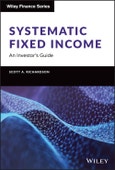Systematic Fixed Income: An Investor’s Guide offers readers a powerful, practical, and robust framework for investors and asset managers to preserve the diversifying properties of a fixed income allocation, and add to that unique sources of excess returns via systematic security selection. In other words, this framework allows for efficient capture of fixed income beta and fixed income alpha.
Celebrated finance professional Dr. Scott Richardson presents concrete strategies for identifying the relevant sources of risk and return in public fixed income markets and explains the tactical and strategic roles played by fixed income in typical portfolios. In the book, readers will explore: - The implementation challenges associated with a systematic fixed income portfolio, including liquidity and risk - The systematic return sources for rate and credit sensitive fixed income assets in both developed and emerging markets
An essential read for asset managers and institutional investors with a professional interest in fixed income markets, Systematic Fixed Income: An Investor’s Guide deserves a place in the libraries of advanced degree students of finance, business, and investment, as well as other investment professionals seeking to refine their understanding of the full potential of this foundational asset class.
Table of Contents
Preface xiii
Acknowledgments xv
About the Author xvii
Chapter 1 Setting the Stage 1
1.1 What is fixed income? 1
1.2 How big are fixed income markets? 3
1.3 What does it mean to be systematic? 8
1.4 Which fixed income markets will this book focus on? 15
1.5 Commonly used fixed income analytics 17
1.6 Other fixed income considerations 24
References 28
Chapter 2 Fixed Income - Strategic Asset Allocation 29
2.1 What are the key drivers of fixed income security returns? 29
2.2 What traditional risk premia can be harvested in fixed income? 36
2.3 The strategic diversification benefit of fixed income 50
2.4 Is the strategic diversification benefit of fixed income threatened in a low-interest-rate environment? 54
References 55
Chapter 3 Fixed Income - Tactical Asset Allocation 57
3.1 Market timing - term premium 57
3.2 Market timing - credit premium 70
3.3 Other considerations 83
References 88
Chapter 4 Incumbent Active Fixed Income Managers 89
4.1 Framework for active fixed income management 89
4.2 US Aggregate (Core Plus) benchmarked fixed income managers 94
4.3 Global Aggregate benchmarked fixed income managers 97
4.4 Unconstrained Bond Funds 100
4.5 Emerging Market fixed income managers 102
4.6 Credit long/short managers 104
References 108
Chapter 5 Security Selection - Rate-Sensitive Assets 109
5.1 What is the investment opportunity set for developed market government bonds? 109
5.2 Reducing the dimensionality 112
5.3 A framework for security selection of government bonds (investment themes) 119
5.4 A framework for security selection of government bonds (level, slope, and curvature) 123
5.5 Extensions 131
References 135
Chapter 6 Security Selection - Credit-Sensitive Assets 137
6.1 What is the investment opportunity set for developed market corporate bonds? 137
6.2 Dimensions of active risk taking within corporate bonds 145
6.3 A framework for security selection of corporate bonds (investment themes) 149
6.4 A framework for security selection of corporate bonds (performance) 158
6.5 Extensions 163
References 170
Chapter 7 Security Selection - Emerging Markets (Hard Currency) 173
7.1 What is the investment opportunity for emerging market fixed income? 173
7.2 A framework for security selection of hard currency emerging market bonds (investment themes) 178
7.3 A framework for security selection of emerging market hard currency bonds (performance) 182
7.4 Extensions 184
References 186
Chapter 8 Portfolio Construction Considerations 187
8.1 Choices in the investment process (design and investment universe) 187
8.2 Choices in the investment model (expected returns) 191
8.3 Choices in the portfolio construction process (optimization, rebalancing, trading) 199
8.4 Other topics 207
References 208
Chapter 9 Liquidity and Trading Considerations 209
9.1 Some context for the liquidity challenges of fixed income assets 209
9.2 Basics for trading credit-sensitive assets 210
9.3 Electronification of trading for credit-sensitive assets 219
9.4 Primary markets - liquidity provision 221
9.5 Secondary markets - liquidity provision 226
9.6 Ancillary topics 228
References 232
Chapter 10 Sustainability 233
10.1 Interest in ESG/sustainability 233
10.2 Sustainable investing with credit-sensitive assets 235
10.3 Sustainable investing with rate-sensitive assets 249
References 256
Chapter 11 Putting It All Together 259
11.1 What might a successful systematic fixed income investing process look like? 259
11.2 Some final thoughts 272
Reference 277
Index 279








